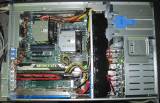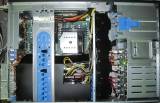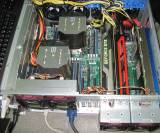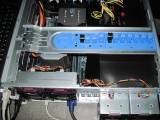This is an old revision of the document!
Table of Contents
HPC Village
HPC Village from Openwall is an opportunity for HPC (High Performance Computing) hobbyists alike to program for a heterogeneous (hybrid) HPC platform. Participants are provided with remote access (via the SSH protocol) to a server with multi-core CPUs and HPC accelerator cards of different kinds - Intel MIC (Xeon Phi), AMD GPU, NVIDIA GPU - as well as with pre-installed and configured drivers and development tools (SDKs).
We provide within one machine access to the mentioned four types of computing devices, including OpenCL support for all of them, as well as support for development tools and usage models specific to some of them (OpenMP on CPU, OpenMP offload from CPU to MIC, CUDA on NVIDIA GPU). Although it is uncommon to use more than two types of computing devices within one node in real-world HPC setups, such configuration is convenient for getting acquainted with the different technologies, for trying out and comparing them on specific tasks, and for development of portable software programs (including debugging and optimization).
Hardware
The current hardware configuration is as follows:
- Supermicro GPU SuperWorkstation 7047GR-TPRF workstation/server platform with MCP-290-00059-0B rackmount rail set
- 4U chassis
- Two 1620W PSUs 1)
- Dual socket 2011 motherboard with IPMI, 16 memory sockets, four PCIe 3.0 x16 slots for full-length dual-width PCIe cards (and a fifth slot for a shorter card)
- A full set of cooling fans, including those pulling hot air out of passively-cooled accelerator cards
- Two 8-core Xeon E5-2670 CPUs
- Sandy Bridge-EP, support AVX and AES-NI
- A total of 16 CPU cores seen as 32 logical CPUs (two hardware threads per core), at a clock rate of at least 2.6 GHz
- Turbo boost to up to 3.0 GHz with all cores in use or 3.3 GHz with few cores in use
- 128 GB DDR3-1600 ECC RAM
- 8x 16 GB DDR3-1600 ECC Registered modules on 8 channels (4 channels per CPU)
- Theoretical bandwidth 102.4 GB/s, actual measured bandwidth ~85 GB/s (cumulative from 32 threads)
- Xeon Phi 5110P coprocessor module
- 60 cores (x86-ish with 512-bit SIMD units) seen as 240 logical CPUs (four hardware threads per core), 1.053 GHz, 8 GB GDDR5 ECC RAM on a 512-bit bus, 320 GB/s
- Peak performance of about 2 TFLOPS single-precision, 1 TFLOPS double-precision
- AMD Radeon HD 7990 gaming graphics card
- Two “Tahiti” GPUs, which provides 2×2048 SPs at 1 GHz, 6 GB GDDR5 RAM on two 384-bit buses, 576 GB/s
- Peak performance of over 8 TFLOPS single-precision, about 2 TFLOPS double-precision
- This is a budget replacement for the FirePro S10000 GPU card intended for servers (which would cost at least 3 times more and would run considerably slower, but would offer ECC RAM)
- NVIDIA GTX TITAN gaming graphics card (Zotac GeForce GTX TITAN AMP! Edition)
- One GK110 GPU with 2688 SPs at 902 MHz to 954 MHz in single-precision mode, 6 GB GDDR5 RAM on a 384-bit bus, 317.2 GB/s
- Peak performance of over 5 TFLOPS single-precision, from 1.3 to 1.5 TFLOPS double-precision in the corresponding mode
- This is a budget replacement for the TESLA K20X GPU card intended for workstations and servers (which would cost at least 3 times more and would run considerably slower at single-precision and integer code, but would offer ECC RAM)
Total peak performance is over 15 TFLOPS single-precision, about 4.5 TFLOPS double-precision.
Here's what the server looks like (click on the thumbnails for higher resolution pictures):
Software
The operating system is Scientific Linux 6.6, since this is a common free option to run Intel MPSS as needed to access the Xeon Phi card (which, in turn, runs its own copy of Linux, coming from Intel MPSS).
Here's what this looks like via OpenCL:
[solar@super ~]$ clinfo | egrep '^ (Platform |)Name:' | tail -n +4 Platform Name: AMD Accelerated Parallel Processing Name: Tahiti Name: Tahiti Name: Intel(R) Xeon(R) CPU E5-2670 0 @ 2.60GHz Platform Name: Intel(R) OpenCL Name: Intel(R) Xeon(R) CPU E5-2670 0 @ 2.60GHz Name: Intel(R) Many Integrated Core Acceleration Card Platform Name: NVIDIA CUDA Name: GeForce GTX TITAN
Curiously, “Tahiti” appears twice because there are two such GPUs (they're device 0 and 1, respectively), whereas the CPUs appear twice because they're available via both AMD's and Intel's OpenCL SDK, and either SDK will use all cores of both CPUs.
Who is eligible
Remote access will be provided, free of charge, to Open Source software developers. Access is provided for getting acquainted with the technologies and/or for Open Source software development. In the organizers' sole discretion, access may be denied or restricted (in particular, in case it is used for other than an intended purpose or/and if one's use of the system inconveniences other users in a substantial way). The information contained in this announcement does not formally constitute an offer to provide any service to the general public.
How to apply
To apply for an HPC Village account, please e-mail hpc-village-admin at openwall.com with the following information:
- Names of and URLs to Open Source project(s) that you represent, and a way for us to confirm that you're in fact involved with those projects
- Desired login name (must be non-misleading to other users)
- Your SSH public key, preferably from a keypair generated according to our conventions
We intend to reply to all HPC Village accounts request e-mails.
Credits
The HPC Village project is provided by Openwall (idea, computer hardware parts, software configuration, system administration) and DataForce (assembly and hosting of servers, Internet connectivity).
Related third-party projects/offers
Please note that Openwall is not affiliated with any of these.
Free access to multi-CPU servers (including some non-x86) for Open Source development:
Use Sage, R, Octave, Python, Cython, GAP, Macaulay2, Singular, and much more, write, compile, and run code in most programming languages on remote systems using a free service (with support from University of Washington, the National Science Foundation, and Google):
Time-limited free access to an HPC machine, with intent to promote these vendors' computer hardware sales:
HPC application hosting (paid):




